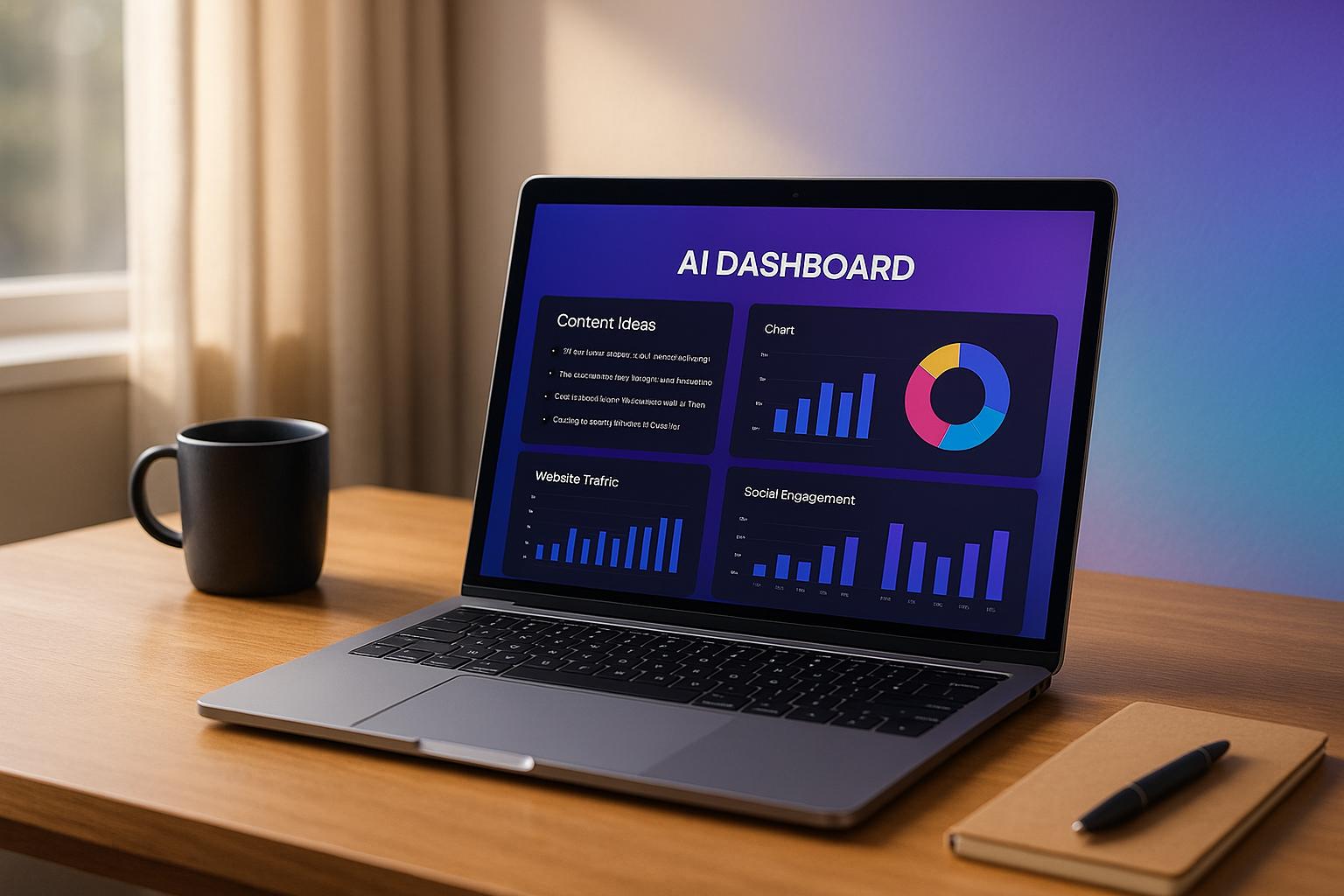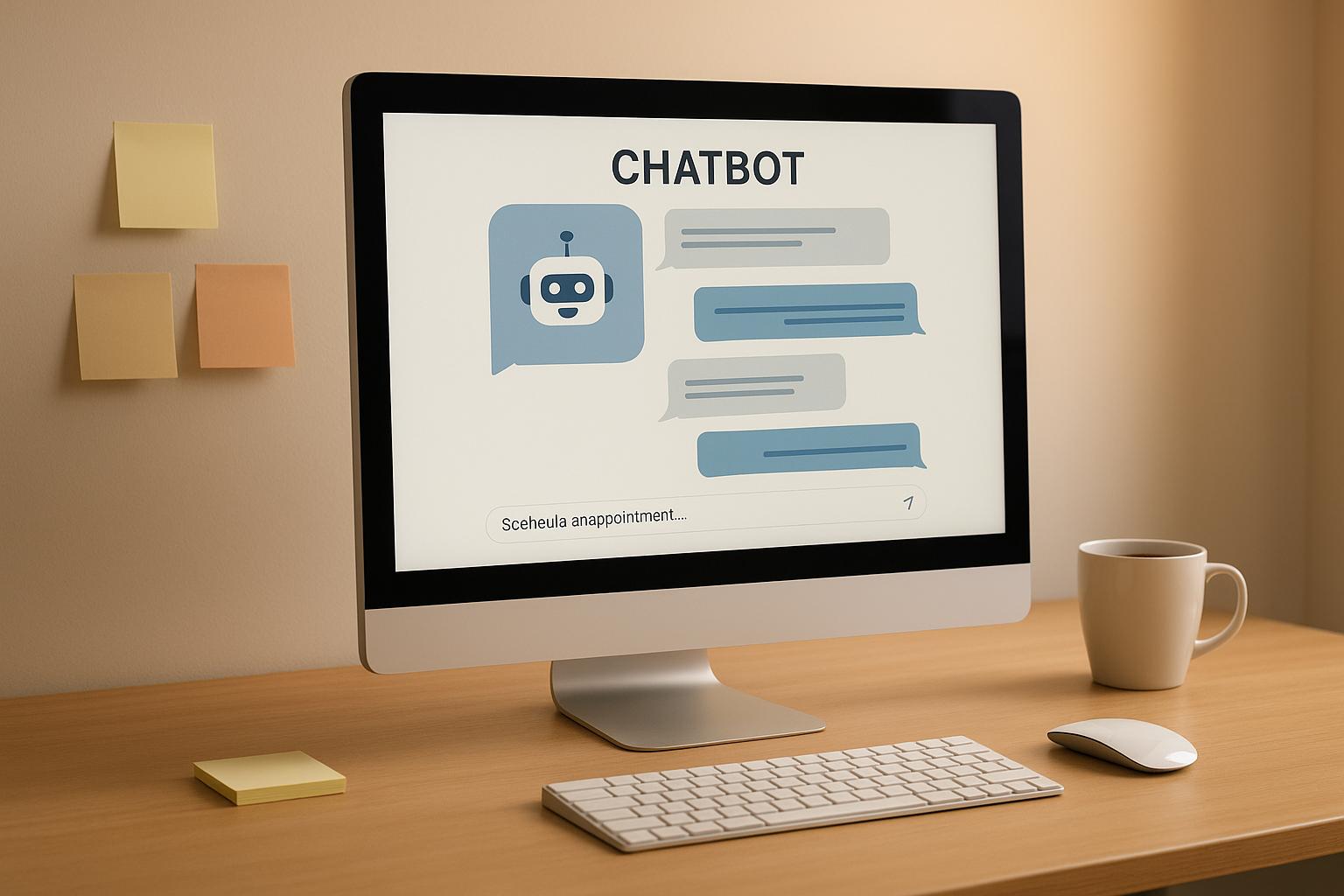In 2025, the chatbot industry is a $15.57 billion market and is projected to triple by 2029. With chatbots driving 67% sales growth, resolving complaints 90% faster, and improving customer satisfaction by 24%, starting a chatbot agency is a smart move. Here's how to get started:
-
Why Chatbots?
Businesses save $11 billion annually with AI bots, and 88% of consumers interacted with one last year. Industries like healthcare and finance are leading adoption. -
Key Tools & Costs:
Basic bots cost $5,000, while advanced ones exceed $500,000. Use tools like LangChain for development, Supabase for backend, and AgentOps for monitoring. -
Build Your Agency:
- Register your business and secure insurance.
- Hire experts in AI, data, and compliance.
- Offer industry-specific templates (e.g., e-commerce, healthcare).
-
Win Clients:
Help businesses reduce missed calls, automate bookings, and improve customer service. Show ROI with metrics like lead conversions or cost savings. -
Scale Smartly:
Automate updates, monitor performance, and ensure data protection with GDPR-compliant systems.
With the right tools, team, and strategy, you can tap into this growing market and create a successful chatbot agency.
Step 1: Current Chatbot Market Analysis
Top Industries Using Chatbots
In 2025, the healthcare sector is leading the way in adopting chatbots. Projections estimate the market will hit $543 million by 2026, with a growth rate of 15.2% annually. Currently, 52% of U.S. patients use chatbots to access health data, and these tools are expected to automate 73% of administrative tasks.
Here are a few examples:
| Healthcare Provider | Implementation | Impact |
|---|---|---|
| Mayo Clinic | Med-PaLM Integration | Better patient care and faster query responses |
| Formiz Women's Hospital | Booking System | Easier appointment scheduling |
| Maypure Clinic | Patient Management | More efficient administration |
The financial services industry is also heavily investing in chatbots. Companies like Charles Schwab have rolled out AI assistants to provide financial guidance. These efforts are paying off - businesses report a 67% boost in lead conversions after deploying chatbot solutions. This trend highlights how rapidly chatbot technology is transforming industries.
Current Market Developments
Three major advancements are driving the evolution of chatbots in 2025:
-
Natural Language Processing (NLP)
The NLP market is forecasted to reach $35 billion by 2025. This technology allows chatbots to better understand context and subtle nuances, resulting in a 20% jump in customer satisfaction and a 10–15% rise in revenue through personalized interactions. -
Voice Technology Integration
Voice-enabled chatbots are becoming a standard feature. By the end of 2025, over half of U.S. households are expected to own smart speakers. Bernard Marr, a well-known technology expert, predicts voice assistants will become increasingly lifelike. -
Autonomous AI Capabilities
Advanced bots are now capable of solving complex problems without human help. Surveys show that 70% of customers expect chatbots to handle issues independently.
Legal and Ethics Guidelines
The FTC has laid out strict rules for chatbot use, focusing on these key areas:
| Requirement | Description |
|---|---|
| Transparency | Clearly disclose when AI is being used in customer interactions. |
| Risk Mitigation | Ensure bots do not produce harmful or misleading outputs. |
| Advertising Clarity | Clearly differentiate between organic and sponsored content. |
| Consumer Protection | Protect users from manipulation through AI avatars. |
| Privacy Standards | Obtain explicit consent before collecting or using personal data. |
Recent enforcement actions underline the importance of following these rules. For instance, in January 2025, the FTC fined DoNotPay, Inc. $193,000 for making unverified claims about its AI capabilities. Additionally, companies operating in states like Illinois, Washington, and Texas must secure prior consent before collecting biometric data, such as voiceprints.
How to Build and Scale an AI Chatbot Agency: Step-by-Step Guide
Step 2: Building Your Agency Foundation
Once you’ve identified the market potential, it’s time to lay the groundwork for your AI chatbot agency.
Business Setup Requirements
Starting an AI chatbot agency involves several legal and administrative steps. First, decide on your business structure. For those planning to attract venture capital, forming a C corporation is often recommended by legal experts.
Here are the key steps to get your business up and running:
| Requirement | Description |
|---|---|
| Business Registration | File incorporation documents and secure an Employer Identification Number (EIN). |
| Licenses & Permits | Obtain the required state and local permits. |
| Insurance Coverage | Get professional liability and cyber insurance. |
| Data Protection | Ensure compliance with GDPR and CCPA regulations. |
| IP Protection | Use non-disclosure and confidentiality agreements to safeguard intellectual property. |
Industry experts highlight the importance of building a team with expertise in data handling, AI technologies, and regulatory compliance.
Required Technology Stack
Your technology setup should support both the development of chatbots and smooth client management. Here’s a breakdown of the essential tools for 2025:
| Category | Core Tools | Purpose |
|---|---|---|
| Development | CopilotKit, LangChain | For creating and customizing AI chatbots. |
| Backend | Supabase | Handles database management and vector similarity searches. |
| Security | E2B | Provides secure sandbox environments. |
| Monitoring | AgentOps | Tracks performance and optimizes processes. |
| Data Processing | Tavily | Enables real-time information retrieval. |
To streamline deployment, consider integrating these tools with White Label AI Solutions. This setup ensures your team can work efficiently and effectively.
Team Structure and Roles
Building a capable team is crucial to bringing your vision to life. A mix of in-house experts and specialized contractors can help reduce costs by up to 60%.
Key roles to fill include:
-
Technical Leadership
An AI Architect to lead development efforts and a Machine Learning Engineer to fine-tune models. -
Data Management
Data Scientists and Engineers to oversee infrastructure and modeling tasks. -
Ethics and Compliance
An AI Ethicist to guide responsible AI development and ensure compliance with regulations.
Step 3: Creating Chatbot Solutions
Pre-Built Industry Templates
Industry-specific templates can speed up chatbot deployment. These templates act as a starting point, allowing customization to fit each client's specific needs.
| Industry | Primary Use Cases | Key Features |
|---|---|---|
| E-commerce | Product recommendations, order tracking, refunds | Inventory integration, payment processing |
| Real Estate | Property matching, viewing scheduling | Location services, appointment booking |
| Healthcare | Appointment scheduling, symptom checking | HIPAA compliance, medical terminology |
| Financial Services | Account inquiries, transaction support | Security protocols, regulatory compliance |
When using these templates with White Label AI Solutions, you can adjust the interface to reflect your brand - think colors, typography, and logos - without altering the core functionality. This makes deployment faster while still improving customer interactions. For instance, Suzanne Duffy, Head of Customer Service at Papier, shared:
"Even if the AI Agent isn't resolving queries, it frees up agent time to work on the more complex issues. It will collect order IDs, ask for a picture upload if something is faulty, and it'll do all of that legwork upfront."
Once the templates are set up, focus on enhancing your chatbot's interaction skills.
AI Response Training Methods
To ensure accurate and natural conversations, train your chatbot using these three main components:
-
Intent Recognition
Clearly define intents like property searches, price inquiries, or appointment scheduling, depending on your industry. -
Entity Extraction
Teach your chatbot to recognize and pull key details such as:- Dates and times
- Monetary values
- Location data
- Product specifications
-
Response Optimization
Fine-tune responses by:- Analyzing performance data
- Using user feedback
- Running A/B tests
- Matching the tone to your brand's voice
Once trained, ensure your chatbot is ready to perform consistently across all platforms.
Multi-Platform Integration
Today’s chatbots need to work smoothly across multiple platforms while maintaining the same level of functionality.
| Platform | Integration Requirements | Customization Focus |
|---|---|---|
| Website | JavaScript snippet implementation | UI elements |
| Business API integration | Rich media support | |
| Facebook Messenger | Graph API configuration | Interactive components |
| Mobile Apps | SDK implementation | Native features |
| Slack | Events API setup | Commands |
To ensure success across platforms:
- Build a platform-independent core for consistent functionality.
- Use a scalable, cloud-based architecture supported by White Label AI Solutions.
- Track cross-platform analytics to continually improve performance.
Step 4: Getting and Keeping Clients
Market Selection and Targeting
Local businesses lose a staggering $1.6 billion every year due to missed calls, with only 38% of calls being answered.
Focus on industries where quick responses directly impact revenue:
- Real estate agencies and medical practices missing out on key inquiries and bookings
- Law firms losing potential case consultations
- Service businesses with high call volumes that require immediate attention
Highlight the return on investment (ROI) by asking a simple but powerful question: "How much is one client worth to you?". This frames the monthly cost of $300–$500 in terms of the revenue it can generate.
| Industry Pain Point | Value Proposition | Success Metric |
|---|---|---|
| Missed calls during peak hours | 24/7 response capability | Captured leads |
| Manual appointment scheduling | Automated booking system | Time saved |
| Basic customer inquiries | Instant response to FAQs | Customer satisfaction |
| After-hours availability | Round-the-clock service | Extended coverage |
Measuring Success Metrics
Track these metrics to demonstrate the value of your service:
| Metric | Target Range | Business Impact |
|---|---|---|
| Self-Service Rate | 70–80% | Reduced staff workload |
| Performance Rate | >85% | Improved response accuracy |
| User Satisfaction | >87% | Better customer experience |
| Goal Completion | >75% | Higher conversion rates |
For example, one case study revealed that implementing AI added $77,000 to a client’s pipeline in just one month.
"If I could get you five appointments in 5 days using AI for free, with no ad spend or fees, would you be able to handle that?" – Money Tent
These metrics are the building blocks for a smooth and effective client onboarding process.
Client Setup with White Label AI Solutions
Setting up clients with white label AI solutions involves three key phases:
1. Brand Integration
- Customize the chatbot’s appearance to match the client’s branding
- Adjust the tone of conversations to reflect the client’s style
- Incorporate specific terminology used by the client
2. System Integration
- Link the chatbot with the client’s existing CRM system
- Configure appointment scheduling features
- Set up payment processing capabilities
3. Performance Optimization
- Monitor and refine response accuracy
- Adjust conversation flows based on user interactions
- Improve lead qualification processes
Companies using AI for sales have reported impressive results, including:
- A 50% increase in leads and appointments
- A 60–70% reduction in call time
- A 40–60% reduction in costs
To maintain high client satisfaction, provide detailed training materials and schedule regular performance reviews. These efforts have helped achieve an average customer satisfaction rate of 87% for chatbot implementations.
Step 5: Growing Your Agency
Maintenance Automation
To scale your chatbot agency, you'll need strong automation systems in place:
- Content Management Automation: Use AI tools to handle real-time updates across chatbot deployments. These tools can monitor knowledge bases and replace outdated information automatically.
-
Security Monitoring: AI-powered security tools are essential for:
- Detecting threats in real time
- Running automated scans
- Managing software patches
- Conducting regular compliance reviews
-
Performance Optimization: Configure systems to:
- Adjust server resources based on demand
- Improve response times during peak usage
- Schedule regular backups
Once these systems are in place, review performance metrics regularly to fine-tune your approach.
Performance Monitoring
Automated systems are just the beginning - monitoring tools ensure your service quality stays consistent as your agency grows. Tools like New Relic AI monitoring can give you a clear view of how your chatbots are performing.
"By using an observability tool like New Relic AI monitoring, you can observe key metrics such as response time, token usage, and error rates to ensure your chatbot performs optimally and delivers a smooth and efficient experience for your users."
To keep performance on track, focus on:
- Fine-tuning LangChain input processing
- Reviewing and optimizing prompt structures
- Keeping an eye on token usage
Consistent maintenance and diligent monitoring are key to earning customer trust and scaling your business effectively.
Data Protection Standards
Protecting client data is non-negotiable. Ensure compliance with GDPR and other regulations by building a solid data protection framework. Here's how:
- Establish Clear Policies: Define how data is collected, stored, and used.
- Consent Management: Use opt-in forms and maintain detailed logs of user consent.
- Encryption: Use AES-256 encryption to secure sensitive data.
- Regular Updates: Keep your data protection practices current.
Additional security measures include:
- End-to-end encryption
- Frequent security audits
- Automated breach detection systems
- Real-time monitoring
"Personal data should only be retained for as long as it is necessary for the purpose it was collected. Once this purpose is fulfilled, data must be deleted or anonymized."
Here’s a quick checklist for data protection:
- User Consent: Use opt-in methods and keep detailed records.
- Data Encryption: Ensure AES-256 encryption is in place and verified through security scans.
- Access Control: Implement role-based permissions and conduct periodic reviews.
- Data Retention: Automate deletion processes and confirm compliance.
Conduct regular Data Protection Impact Assessments (DPIAs) to identify potential risks and address them proactively. Ensure your team receives updated training to stay aligned with the latest protocols.
Conclusion: Starting Your Chatbot Business
Now is the time to launch your chatbot agency. The AI Agent market is projected to reach $47.1 billion by 2030, offering a wealth of opportunities for agencies that can provide tailored solutions.
Focus on industries with strong potential - such as healthcare, finance, and e-commerce - and offer specialized automation services. Businesses using AI for sales have reported impressive outcomes, like cutting call times by 60-70% and reducing costs by 40-60%. This targeted approach can set your agency on a path to long-term success.
"Leverage cutting-edge tools, strategic niche focus, and ethical practices to tap the $47.1 billion market." - GAJENDRA P K KHARE, Author
Building a thriving chatbot agency depends on three core elements:
Technical Foundation
- Ensure strong data governance practices and compliance with regulations.
- Deliver high-performance solutions, addressing the concerns of 41% of enterprises.
Client Success
- Highlight clear ROI through case studies.
- Offer personalized solutions, as 81% of customers now expect tailored experiences.
- Prioritize client retention - repeat customers spend up to 70% more than new ones.
Growth Strategy
- Use white-label solutions to reduce development time by up to 70%.
- Assemble a skilled team with expertise in LLMs, API integrations, and UX design.
- Implement scalable systems for ongoing maintenance and monitoring.
Success in this field isn’t just about technology; it’s about delivering real value to clients while maintaining ethical practices and strong data protection. With the right foundation and a clear strategy, your chatbot agency is positioned to thrive.
FAQs
What legal and ethical factors should I consider when starting a chatbot agency in 2025?
When launching a chatbot agency in 2025, it's essential to address both legal and ethical responsibilities to ensure compliance and build trust with your clients and users.
From a legal standpoint, data privacy should be a top priority. Make sure you comply with regulations like GDPR or CCPA by obtaining user consent, securely managing personal data, and providing clear explanations about how data is used. Transparency and user control are key to maintaining compliance.
Ethically, focus on creating chatbots that are fair, unbiased, and non-discriminatory. Avoid misleading users about the chatbot’s capabilities and be upfront about its limitations. Responsible AI practices, such as reducing bias in responses and ensuring inclusivity, will help you build a trustworthy and sustainable business.
How can a new chatbot agency prove its ROI to potential clients?
To demonstrate ROI effectively, focus on showcasing measurable benefits such as cost savings, revenue growth, and improved customer satisfaction. For instance, chatbots can lower operational costs by automating repetitive tasks, potentially saving businesses up to 40–60% in customer service expenses. They can also boost revenue by qualifying leads more efficiently and driving sales.
Highlighting customer satisfaction is equally important - chatbots provide quick, accurate responses that enhance user experience and build loyalty. Additionally, calculate the cost per automated conversation to show the tangible value your chatbot delivers. Sharing real-world examples from industries like retail, healthcare, or telecommunications can further illustrate the impact and build trust with clients.
How can I ensure data protection and compliance with regulations like GDPR when running a chatbot business?
To protect user data and comply with regulations like GDPR, it's essential to follow best practices:
- Be transparent with users by clearly explaining how their data will be collected, stored, and used. Provide easy access to your privacy policy and obtain explicit consent before collecting any personal information.
- Limit data collection to only what is absolutely necessary for the chatbot's functionality. Avoid storing sensitive information unless legally required and ensure you have a valid legal basis for all data processing activities.
- Secure user data by implementing encryption, access controls, and regular security audits to prevent breaches. Additionally, consider hosting data on servers in GDPR-compliant regions, such as within the European Union.
By prioritizing transparency, minimizing data collection, and maintaining strong security measures, you can build trust with your users while staying compliant with regulatory requirements.


